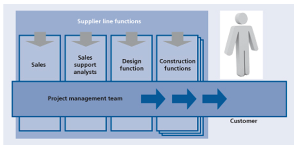PRINCE2 2009 - Directing Projects with PRINCE2 part 10
of the Cabinet Office under delegated authority from the Controller of HMSO.
Project Board duties and behaviours
Facilitate cross-functional integration
The project management team is a temporary, almost always cross-functional, structure set up with specific responsibility for the project.
Project Board members must ensure that this is recognized and respected in the functional or line management organization(s), and that the Project Board’s authority is not undermined.
The organizational structures within which projects are undertaken can vary on a continuum between the strictly functional type at the one extreme and the ‘projectized’ at the other.
Most fall somewhere in between the two extremes and employ various styles of ‘matrix management’.
Projects are typically cross-functional.
That is, they cross internal line function boundaries in organizations or involve entirely separate business entities.
If this characteristic does not apply, i.e. the business, user and supplier interests all come from the same organization and the same line function, the work involved is not really a project - it can be managed more simply as a line ‘task’.
The diagram illustrates a relatively common supplier project.
None of the line functions in this supplier organization see the whole picture - they each contribute differently to the solution for the customer.
For the project to succeed, a customer-facing matrix organization needs to be set up to integrate the efforts of the various contributing line functions and engage with the customer - this is the PRINCE2® project management team.
In effect, the supplier’s line functions are supplying services to the project in the form of specialist quality capabilities, people and/or products.
Services supplied to a project may take two forms:
- Resources: e.g. the design function supplies a designer to the project. This arrangement is sometimes termed a ‘strong project matrix’ because the work is directly managed by the project
- Products: e.g. the design function supplies the completed design. This is termed a ‘weak project matrix’ because the line function manages the work on behalf of the project.
The two types of matrix each have advantages and disadvantages - and projects frequently consist of a mixture of the two.
Strong matrixes, with dedicated resources, tend to be able to respond faster when changes or problems occur but can be wasteful of resources.
Weak matrixes are often implemented to optimize resourcing but at the expense of flexibility and project response.
Difficulties arise when the engagement between the project and the line functions is ineffective.
For example:
- A resource is not available when required
- A product is not delivered on time
- Products from different line functions do not ‘fit together’ properly
These common types of problem may be caused by poor project planning (e.g. providing inadequate notice of requirements) or by conflicting line management priorities, by shortages of resources or by poor communication between the project and/or line functions.
It is the Project Manager’s job to try to establish plans and agreements that anticipate and, where possible, eliminate these obstacles.
Ultimately, though, Project Board members carry much more authority than Project Managers - and it is crucial that they use this influence within the business to ensure that matrix arrangements work effectively for the project (the Senior Supplier would have this responsibility in the example in the diagram).
If the roles of project and line management relative to one another are not clear and efficient, there will be continual stress in the delivery process - with inevitable consequences on performance.
The extent to which problems like this can be avoided usually depends on the extent to which PRINCE2, or the ‘project culture’, is embedded in the overall organization.
Some organizations are much more project-oriented than others.
This means that the temporary project management teams are recognized and accorded a degree of authority similar to (or even higher than) the permanent line functions within the business.
The PRINCE2 Maturity Model (P2MM) provides valuable additional guidance on embedding a project culture and improving overall project performance within organizations.
All references above are in Directing Successful Projects with PRINCE2 unless stated otherwise.
PRINCE2® is a Registered Trade Mark of the Office of Government Commerce in the United Kingdom and other countries.
Managing Successful Projects with PRINCE2 - 2005 edition
Managing successful Projects with PRINCE2 – 2009 edition
Directing Projects with PRINCE2.
plus:
The Complete Project Management package.
And much more besides - at a fantastic price.



